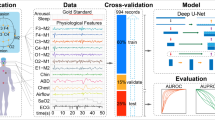Abstract
Sleep disorders can seriously affect human health. Most of the previous studies focused on sleep disorders of apnea, but few on non-apnea. This type of sleep disorder is complex and difficult to detect by traditional methods. In this paper, a physiological time series segmentation network U-Sleep based on deep learning is proposed to analyze these sleep disorders. U-Sleep is a time series convolution network based on U-Net architecture. U-Sleep uses the sequence to sequence input-output mode to map multiple complete original polysomnograms to a single tag sequence. This enables our model to automatically learn the variable interaction between different signals and any related time dependence, and automatically extract such arousal features from the rich physiological time series. We conducted three-fold cross-validation, and use the ensemble model strategy to get the final detection results. Experiments on the datasets of PhysioNet show that the average performance of the final model is: accuracy(0.886), F1(0.892), AUROC(0.916), AUPRC(0.797), SE(0.804), and AI(6.240).
Access this chapter
Tax calculation will be finalised at checkout
Purchases are for personal use only
Similar content being viewed by others
References
Rosenberg, R.S., Van Hout, S.: The American academy of sleep medicine inter-scorer reliability program: respiratory events. J. Clin. Sleep Med. 10(04), 447–454 (2014)
Berry, R.B., et al.: Rules for scoring respiratory events in sleep: update of the 2007 AASM manual for the scoring of sleep and associated events. J. Clin. Sleep Med. 8(05), 597–619 (2012)
Engleman, H.M., Douglas, N.J.: Sleep 4: sleepiness, cognitive function, and quality of life in obstructive sleep apnoea/hypopnoea syndrome. Thorax 59(7), 618–622 (2004)
Jia, B., Lv, J., Liu, D.: Deep learning-based automatic downbeat tracking: a brief review. Multimedia Syst. 25(6), 617–638 (2019). https://doi.org/10.1007/s00530-019-00607-x
Ragnarsdóttir, H., Marinósson, B., Finnsson, E., Gunnlaugsson, E., Ágústsson, J. S., Helgadóttir, H.: Automatic detection of target regions of respiratory effort-related arousals using recurrent neural networks. In: 2018 Computing in Cardiology Conference (CinC), pp. 1–4. IEEE, Holland (2018)
Cho, S.P., Lee, J., Park, H. D., Lee, K.J.: Detection of arousals in patients with respiratory sleep disorders using a single channel EEG. In: 2005 IEEE Engineering in Medicine and Biology 27th Annual Conference, pp. 2733–2735. IEEE, Shanghai, China (2006)
Mesaros, A., Heittola, T., Virtanen, T.: Metrics for polyphonic sound event detection. Appl. Sci. 66, 162 (2016)
Sanchis, J.R.S., Guerrero, J., Olivas, E.S., Lopez, A.J.S.: Neural networks for the detection of EEG arousal during sleep. In: Proceedings of the 6th Internet World Congress for Biomedical Sciences, Ciudad Real, Spain (2000)
Miller, D., Ward, A., Bambos, N.: Automatic sleep arousal identification from physiological waveforms using deep learning. In: 2018 Computing in Cardiology Conference (CinC), pp. 1–4. IEEE, Holland (2018)
Pacheco, O.R., Vaz, F.: Integrated system for analysis and automatic classification of sleep EEG. In: Proceedings of the 20th Annual International Conference of the IEEE Engineering in Medicine and Biology Society, Biomedical Engineering Towards the Year 2000 and Beyond, vol. 20, pp. 2062–2065. IEEE (1998)
Álvarez-Estévez, D., Moret-Bonillo, V.: Identification of electroencephalographic arousals in multichannel sleep recordings. IEEE Trans. Biomed. Eng. 58(1), 54–63 (2010)
Perslev, M., Jensen, M., Darkner, S., Jennum, P.J., Igel, C.: U-Time: A fully convolutional network for time series segmentation applied to sleep staging. In: Advances in Neural Information Processing Systems, pp. 4417–4428. (2019)
Kim, H., Jun, T. J., Kim, D.: Recurrent neural networks-based sleep arousal detection model using MFCC as a feature vector. (2018)
Ronneberger, O., Fischer, P., Brox, T.: U-net: convolutional networks for biomedical image segmentation. In: International Conference on Medical image computing and computer-assisted intervention, LNCS, vol. 9351, pp. 234–241. Springer, Cham (2015). https://doi.org/10.1007/978331924574428
Shoeb, A., Sridhar, N.: Evaluating convolutional and recurrent neural network architectures for respiratory-effort related arousal detection during sleep. In: 2018 Computing in Cardiology Conference (CinC), pp. 1–4. IEEE, Holland (2018)
Singh, S.A., Majumder, S.: A novel approach OSA detection using single-lead ECG scalogram based on deep neural network. J. Mech. Med. Biol. 19(04), 1950026 (2019)
Ghassemi, M.M., et al.: You snooze, you win: the physionet/computing in cardiology challenge 2018. In: 2018 Computing in Cardiology Conference (CinC), pp. 1–4. IEEE (2018)
Odena, A., Dumoulin, V., Olah, C.: Deconvolution and checkerboard artifacts. Distill 1(10), e3 (2016)
Kingma, D. P., Ba, J.: Adam: A method for stochastic optimization. arXiv preprint arXiv:1412.6980 (2014)
Chambon, S., Galtier, M.N., Arnal, P.J., Wainrib, G., Gramfort, A.: A deep learning architecture for temporal sleep stage classification using multivariate and multimodal time series. IEEE Trans. Neural Syst. Rehabil. Eng. 26(4), 758–769 (2018)
Acknowledgement
This work is supported in part by the National Key Research and Development Program of China under Contract 2017YFB1002201, in part by the National Natural Science Fund for Distinguished Young Scholar under Grant 61625204, and in part by the State Key Program of the National Science Foundation of China under Grant 61836006.
Author information
Authors and Affiliations
Corresponding author
Editor information
Editors and Affiliations
Rights and permissions
Copyright information
© 2020 Springer Nature Switzerland AG
About this paper
Cite this paper
Yang, S., Jia, B., Chen, Y., Huang, Z.a., Huang, X., Lv, J. (2020). U-Sleep: A Deep Neural Network for Automated Detection of Sleep Arousals Using Multiple PSGs. In: Yang, H., Pasupa, K., Leung, A.CS., Kwok, J.T., Chan, J.H., King, I. (eds) Neural Information Processing. ICONIP 2020. Lecture Notes in Computer Science(), vol 12534. Springer, Cham. https://doi.org/10.1007/978-3-030-63836-8_52
Download citation
DOI: https://doi.org/10.1007/978-3-030-63836-8_52
Published:
Publisher Name: Springer, Cham
Print ISBN: 978-3-030-63835-1
Online ISBN: 978-3-030-63836-8
eBook Packages: Computer ScienceComputer Science (R0)




